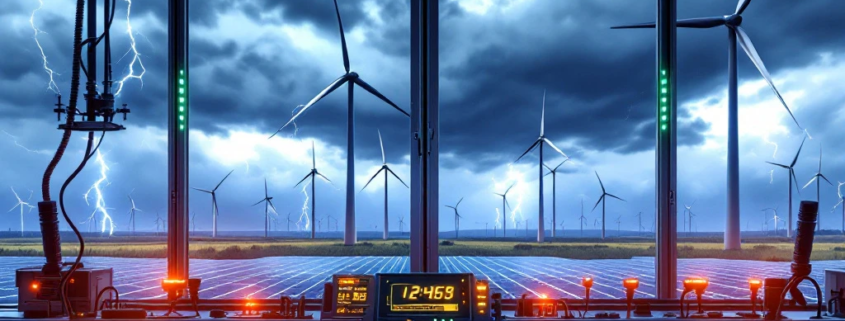What Challenges Exist in Automating Renewable Energy Systems?
Renewable energy automation faces several complex technical hurdles that require sophisticated solutions. These challenges include the variable nature of renewable sources, difficulties in system integration across diverse technologies, massive data management requirements, and the need for advanced control algorithms. Successfully automating renewable energy systems demands expertise in specialized communication protocols, real-time monitoring capabilities, and predictive technologies that can respond to fluctuating energy production while maintaining grid stability and operational efficiency.
What are the primary challenges in automating renewable energy systems?
The automation of renewable energy infrastructure presents unique obstacles that differentiate it from conventional power systems. The inherent variability of renewable sources like solar, wind, and hydro creates fundamental complexities in developing reliable control mechanisms. Unlike fossil fuel plants that offer consistent output, renewable generation fluctuates based on weather conditions, time of day, and seasonal factors.
Integration with existing infrastructure compounds these difficulties. Many power grids were originally designed for one-way distribution from centralized generation plants, not the bidirectional flow required by distributed renewable sources. This necessitates significant modifications to monitoring systems and control architecture to maintain grid stability while accommodating variable inputs.
Advanced control systems must simultaneously manage multiple renewable sources with different operating characteristics while ensuring seamless operation with conventional power plants. These systems require sophisticated algorithms that can forecast production, adjust for fluctuations, and optimize energy flow across the network—all while maintaining regulatory compliance and ensuring system reliability.
How does intermittency affect renewable energy automation?
The unpredictable nature of renewable energy generation creates significant automation challenges that demand specialized solutions. When clouds pass over solar arrays or wind speeds fluctuate, power output can change dramatically within minutes or even seconds. These rapid variations require automation systems with extraordinary responsiveness to prevent grid instability or power quality issues.
Sophisticated forecasting algorithms become essential components of effective renewable automation. These systems analyze weather patterns, historical production data, and real-time measurements to predict energy availability. The most advanced implementations utilize machine learning techniques that continuously improve prediction accuracy, enabling proactive rather than reactive control strategies.
Energy storage integration represents another critical response to intermittency challenges. Automation systems must intelligently manage the charging and discharging of batteries or other storage technologies to buffer fluctuations. This requires complex decision-making capabilities that account for current grid conditions, predicted future generation, storage capacity limitations, and electricity market factors.
Adaptive control systems that can quickly respond to changing conditions form the final piece of the intermittency solution. These systems must maintain grid stability by coordinating multiple resources, including conventional generation, to compensate for renewable fluctuations while optimizing overall system efficiency.
Why is system integration difficult in renewable energy automation?
The diverse ecosystem of renewable technologies creates significant integration hurdles for automation systems. Solar inverters, wind turbine controllers, hydroelectric systems, and biomass plants each use different protocols, data formats, and control architectures. Creating cohesive automation requires bridging these disparate technologies through standardized communication interfaces.
Legacy infrastructure compatibility presents another layer of complexity. Many renewable systems must integrate with existing equipment that may be decades old and use proprietary communication methods. Specialized interface solutions using protocols like CAN bus technology become crucial in creating functional connections between modern and legacy components while maintaining system reliability.
Communication standardization challenges are particularly acute in renewable automation. While traditional power systems often used a single vendor’s ecosystem, renewable installations typically combine equipment from multiple manufacturers. This heterogeneous environment requires automation solutions that can translate between different protocols and create a unified control environment despite hardware diversity.
Real-time coordination requirements add further complexity. Effective renewable automation must synchronize operations across physically dispersed generating assets, often communicating through various network technologies with different latency and reliability characteristics. This distributed nature demands robust communications that can maintain system integrity even when individual connections experience problems.
How can data management challenges be addressed in renewable automation?
The explosive growth in data volume represents one of the most significant challenges in renewable energy automation. Modern installations generate enormous quantities of operational metrics, environmental readings, and performance statistics. Effective automation requires systems capable of collecting, processing, and storing this data while extracting actionable insights in real-time.
Edge computing architectures offer a promising solution by processing data closer to its source. This approach reduces bandwidth requirements and latency while enabling faster responses to changing conditions. By distributing intelligence throughout the system, edge computing creates more resilient automation that can continue functioning even when central systems or communications are compromised.
Cybersecurity considerations become increasingly critical as renewable systems grow more interconnected. Automation solutions must implement robust security protocols to protect against unauthorized access while still allowing legitimate data flow. This requires sophisticated authentication systems, encryption, intrusion detection, and regular security updates that don’t compromise operational reliability.
Scalable data infrastructure forms the foundation of effective renewable automation. Systems must accommodate the continuous addition of new generating assets while maintaining performance and reliability. Cloud-based solutions offer flexibility and processing power that can grow with system needs, though they must be carefully implemented to ensure they meet the real-time requirements of energy automation.
What are the key solutions for overcoming renewable automation challenges?
Advanced control systems with adaptive capabilities represent the cornerstone of effective renewable energy automation. These solutions must continuously optimize operations while responding to fluctuating generation conditions. The most successful implementations leverage artificial intelligence and machine learning to improve performance over time, identifying patterns and optimization opportunities that might escape traditional control approaches.
Standardized communication protocols provide the critical foundation for system integration. Technologies like CAN bus offer robust, deterministic performance even in challenging industrial environments. By implementing consistent communication standards, automation systems can coordinate diverse equipment while simplifying system expansion and maintenance.
Predictive maintenance capabilities significantly enhance system reliability. By analyzing operational data, automation systems can identify potential equipment issues before they cause failures. This proactive approach reduces downtime and maintenance costs while ensuring maximum energy production throughout the system lifecycle.
Perhaps most importantly, specialized engineering expertise remains essential for successfully implementing renewable automation. The complexity of these systems requires deep knowledge across multiple disciplines, including power engineering, communications, software development, and cybersecurity. Organizations that combine technical capabilities with practical experience in renewable integration are best positioned to deliver automation solutions that overcome the unique challenges of renewable energy systems.
For companies navigating the complexities of renewable energy automation, partnering with experienced technology providers offers a path to successful implementation. With the right expertise and technology solutions, the challenges of renewable automation can be transformed into opportunities for increased efficiency, reliability, and sustainability.
Want to optimize your energy infrastructure?
Check out our energy case studies to see how robust CAN topologies and modular designs enhance the reliability of modern energy systems.



